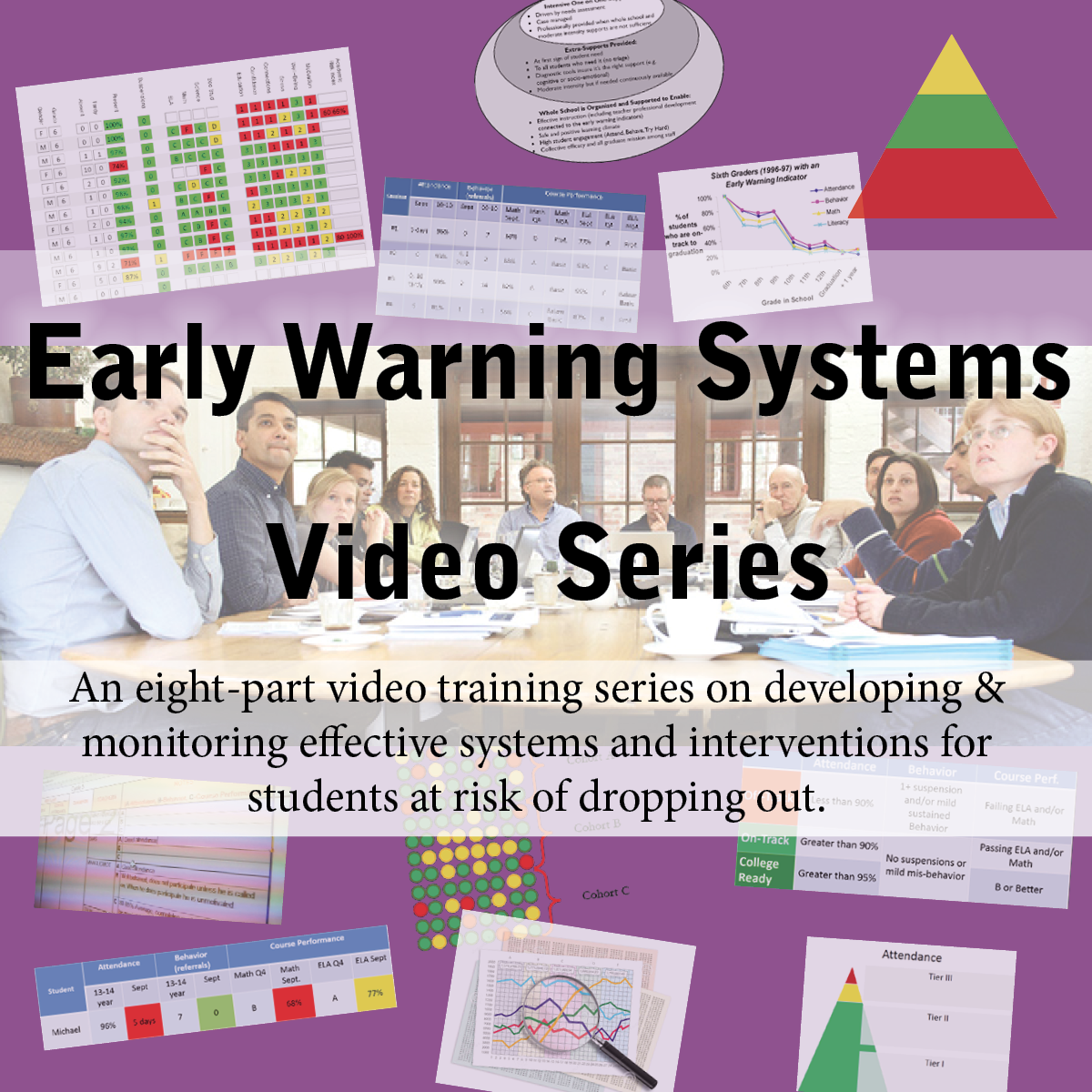Whole-School Improvement Efforts
This section offers resources and lessons that have been learned from efforts to implement evidence-based high school redesign and improvement efforts in a comprehensive manner.
Click to learn more. . .
This free, eight-part in-depth series examines the benefits and steps to implement an effective Early Warning Indicator program.
The videos and materials go far beyond how to collect and interpret EWI data. It also examines building a data culture, linking indicators to a tiered inteventions system, planning EWS for schools and districts, how to get an EWS started including, how to introduce school staff and faculty to the system, intervention review and data gap analysis and much more.
Visit the EWI video series home page.
What the Evidence Says
Want to Share Something?
Have a resource to share? Please share any useful resource, tool, website, etc. that you found helpful during your redesign. . .click here
Have a story to tell? Please share any experience, anecdote, cautionary tale you encountered during your redesign. . .click here
Comprehensive Evidence-based Improvement Efforts
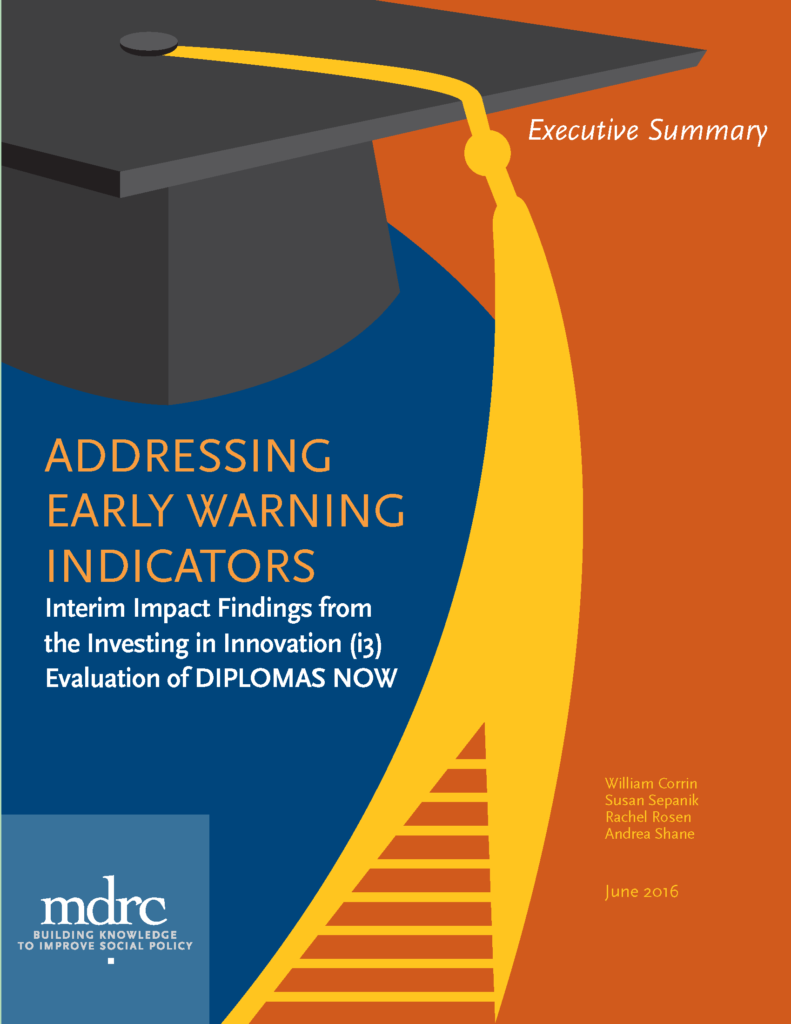 Addressing Early Warning Indicators: Interim Impact Findings from the Investing in Innovation (i3) Evaluation of Diplomas Now from MDRC and ICF International which conducted an independent, experimental evaluation of 62 secondary schools in 11 school districts on the impact and implementation of Diplomas Now.
Addressing Early Warning Indicators: Interim Impact Findings from the Investing in Innovation (i3) Evaluation of Diplomas Now from MDRC and ICF International which conducted an independent, experimental evaluation of 62 secondary schools in 11 school districts on the impact and implementation of Diplomas Now.
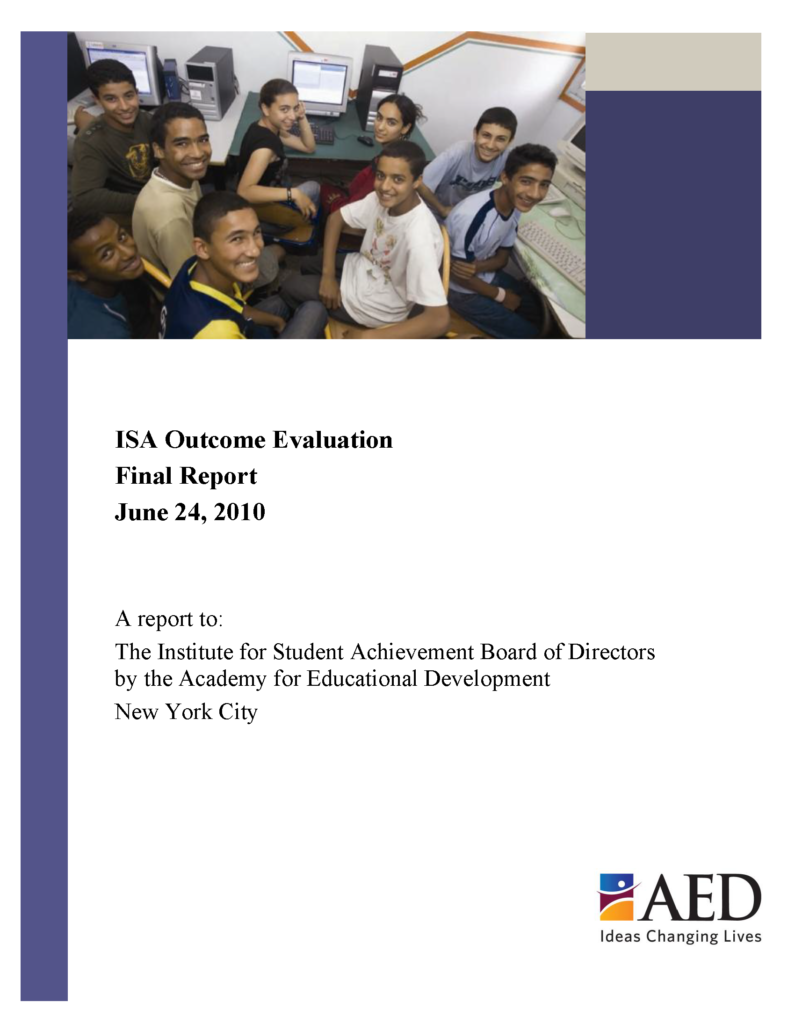 ISA Outcome Evaluation This report summarizes key findings from Academy for Educational Development’s external evaluation of the Institute for Student Achievement (ISA). The six-year evaluation investigated the following key questions: 1) What are the outcomes for ISA students in terms of high school and college achievement?, and 2), How do outcomes for ISA students compare with those of similar students in non-ISA schools?
ISA Outcome Evaluation This report summarizes key findings from Academy for Educational Development’s external evaluation of the Institute for Student Achievement (ISA). The six-year evaluation investigated the following key questions: 1) What are the outcomes for ISA students in terms of high school and college achievement?, and 2), How do outcomes for ISA students compare with those of similar students in non-ISA schools?
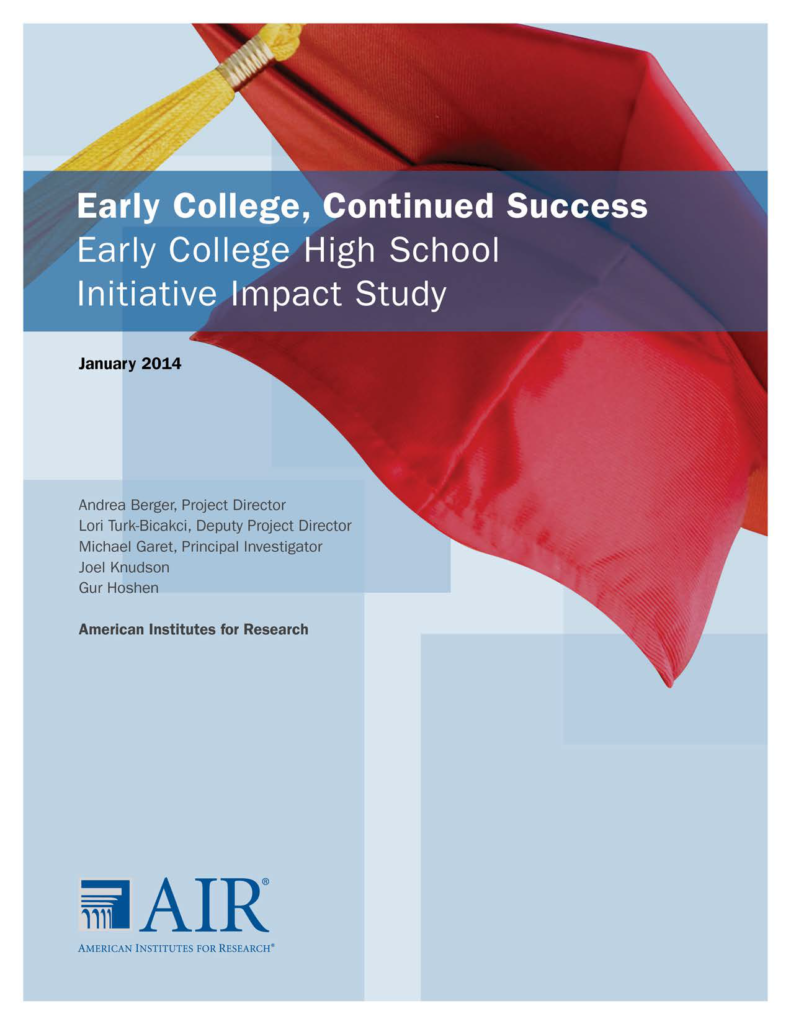 Early College, Continued Success: Early College High School Initiative Impact Study This study from the American Institutes for Research (AIR) focuses on the impact of Early Colleges. It addressed two questions: 1. Do Early College students have better outcomes than they would have had at other high schools? 2. Does the impact of Early Colleges vary by student background characteristics (e.g., gender and family income)?
Early College, Continued Success: Early College High School Initiative Impact Study This study from the American Institutes for Research (AIR) focuses on the impact of Early Colleges. It addressed two questions: 1. Do Early College students have better outcomes than they would have had at other high schools? 2. Does the impact of Early Colleges vary by student background characteristics (e.g., gender and family income)?
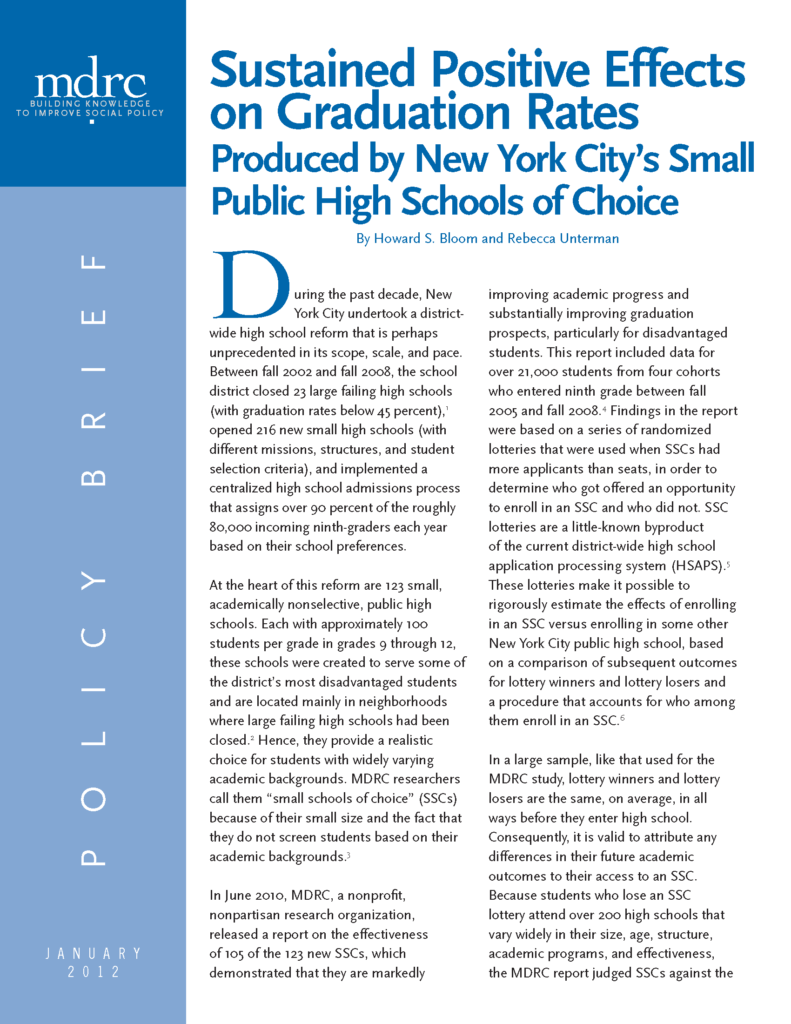 Sustained Positive Effects on Graduation Rates: Produced by New York City’s Small Public High Schools of Choice from MDRC Between fall 2002 and fall 2008, New York City undertook a district-wide high school reform that is perhaps unprecedented in its scope, scale, and pace. The school district closed 23 large failing high schools (with graduation rates below 45 percent),1 opened 216 new small high schools (with different missions, structures, and student selection criteria), and implemented a centralized high school admissions process that assigns over 90 percent of the roughly 80,000 incoming ninth-graders each year based on their school preferences.
Sustained Positive Effects on Graduation Rates: Produced by New York City’s Small Public High Schools of Choice from MDRC Between fall 2002 and fall 2008, New York City undertook a district-wide high school reform that is perhaps unprecedented in its scope, scale, and pace. The school district closed 23 large failing high schools (with graduation rates below 45 percent),1 opened 216 new small high schools (with different missions, structures, and student selection criteria), and implemented a centralized high school admissions process that assigns over 90 percent of the roughly 80,000 incoming ninth-graders each year based on their school preferences.
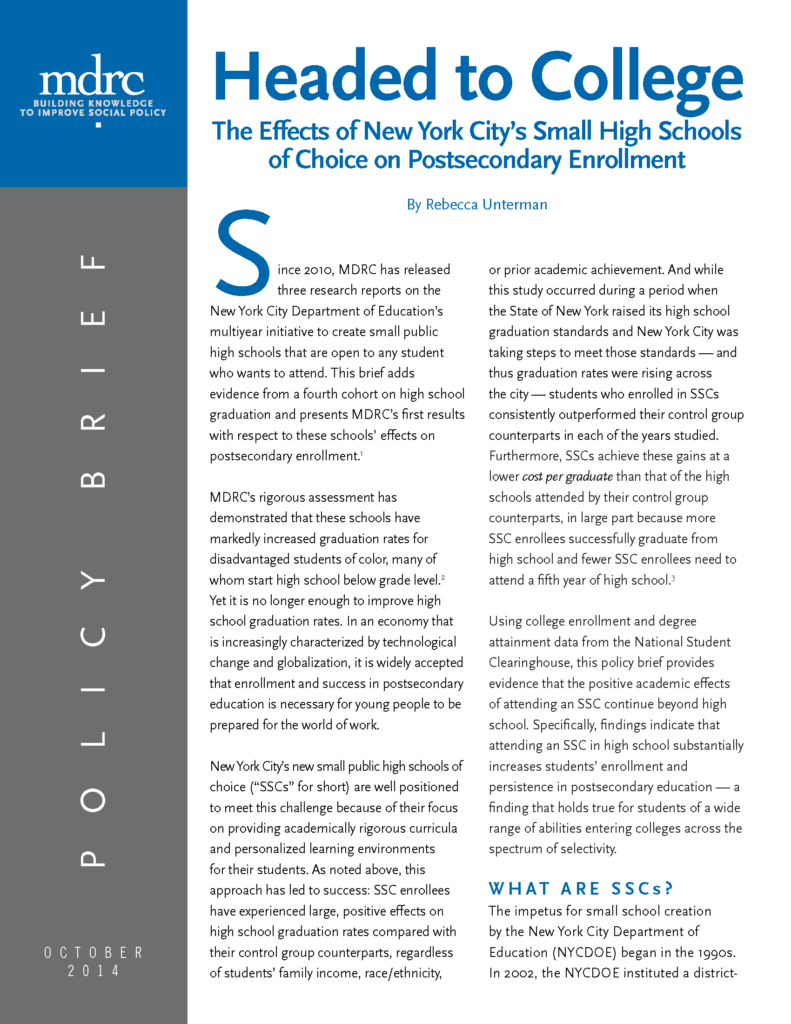 Headed to College: The Effects of New York City’s Small High Schools of Choice on Postsecondary Enrollment Since 2010, MDRC has released three research reports on the New York City Department of Education’s multi-year initiative to create small public high schools that are open to any student who wants to attend. This brief adds evidence from a fourth cohort on high school graduation and presents MDRC’s first results with respect to these schools’ effects on postsecondary enrollment.
Headed to College: The Effects of New York City’s Small High Schools of Choice on Postsecondary Enrollment Since 2010, MDRC has released three research reports on the New York City Department of Education’s multi-year initiative to create small public high schools that are open to any student who wants to attend. This brief adds evidence from a fourth cohort on high school graduation and presents MDRC’s first results with respect to these schools’ effects on postsecondary enrollment.
![]() Reforming Underperforming High Schools from MDRC outlining how urban high schools are in trouble — high dropout rates, low student academic achievement, and graduates who are unprepared for college are just some of the disappointing indicators. However, recent research points to a select number of approaches to improving student outcomes and reforming underperforming schools.</ahref=”https:>
Reforming Underperforming High Schools from MDRC outlining how urban high schools are in trouble — high dropout rates, low student academic achievement, and graduates who are unprepared for college are just some of the disappointing indicators. However, recent research points to a select number of approaches to improving student outcomes and reforming underperforming schools.</ahref=”https:>
![]() Making Progress Toward Graduation: Evidence from the Talent Development Secondary Model from MDRC demonstrates how Talent Development Secondary, which targets some of the most troubled schools in the country, seeks to raise the expectations of teachers and students, with the ultimate goal of preparing all students for post secondary education and employment.
Making Progress Toward Graduation: Evidence from the Talent Development Secondary Model from MDRC demonstrates how Talent Development Secondary, which targets some of the most troubled schools in the country, seeks to raise the expectations of teachers and students, with the ultimate goal of preparing all students for post secondary education and employment.
![]() Small High Schools and Student Achievement: Lottery-Based Evidence from New York City This detailed report shows results of more than 150 unselective small high schools created between 2002 and 2008 have enhanced autonomy, but operate within-district with traditional public school teachers, principals, and collectively-bargained work rules. Lottery estimates show positive score gains in mathematics, English, science, and history, more credit accumulation, and higher graduation rates.
Small High Schools and Student Achievement: Lottery-Based Evidence from New York City This detailed report shows results of more than 150 unselective small high schools created between 2002 and 2008 have enhanced autonomy, but operate within-district with traditional public school teachers, principals, and collectively-bargained work rules. Lottery estimates show positive score gains in mathematics, English, science, and history, more credit accumulation, and higher graduation rates.


